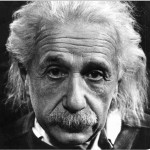 When people are discussing energy, how many conversations revolve around physics and its role in developing better renewable energy? I’d venture a guess and say for most people, the answer is never. Until now. This week I read, “Everyone’s Guide to Atoms, Einstein and the Universe” by Robert Piccioni. Had I had Piccioni for my Physics 101 class, I would have had a much better grade.
When people are discussing energy, how many conversations revolve around physics and its role in developing better renewable energy? I’d venture a guess and say for most people, the answer is never. Until now. This week I read, “Everyone’s Guide to Atoms, Einstein and the Universe” by Robert Piccioni. Had I had Piccioni for my Physics 101 class, I would have had a much better grade.
 Although I enjoyed the entire book, I’m going to focus on two chapters, “Energy, Mass and E=mc2”and “Smart Energy”. Einstein brought to the world its understanding of mass and energy and demonstrated that the two are united and that mass can be converted to different forms of energy. But what exactly is energy? “…energy is the currency of existence….Energy cannot be created nor destroyed; it can only be converted from one form to another.”
Although I enjoyed the entire book, I’m going to focus on two chapters, “Energy, Mass and E=mc2”and “Smart Energy”. Einstein brought to the world its understanding of mass and energy and demonstrated that the two are united and that mass can be converted to different forms of energy. But what exactly is energy? “…energy is the currency of existence….Energy cannot be created nor destroyed; it can only be converted from one form to another.”
The definition above is very apropos considering we are entering into a new energy economy that will have its own currency (hopefully one that is less expensive than our fossil fuel based energy currency we now have). But what is the best way to convert mass to energy?
According to Piccioni, in 2004 in order to provide the world’s energy needs, the conversion of 6 tons of mass to energy was required. The U.S. share was about 1 ton. It may not seem like much, but this is a lot. And burning of coal, oil and biomass will always be inefficient (and yes, physics supplies the answer to why this is so).
So what is more efficient? Nuclear fusion (not to be confused with nuclear fission) which can release millions of times more energy than a typical chemical reaction and its end products are more benign. Although we can’t currently generate energy this way, eventually, Piccioni predicts that we’ll be able to “burn water” to create renewable energy and eventually hydrogen fusion will give us virtually unlimited supply of clean energy from hydrogen in the ocean.
You’ll have to read the book to learn the science behind how this could happen but it’s fascinating to read about what our energy future may look like beyond the energy sources we’re commonly discussing today.
What the book? Click here. And if you have a book you’d like me to review, contact me at jms@4RCommunications.com.

